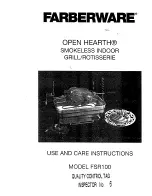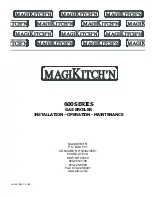
83
2.2.2
Filter on the gas pipe
The gas valve is supplied ex factory with an
inlet filter, which, however, is not adequate
to entrap all the impurities in the gas or in
gas main pipes.
To prevent malfunctioning of the valve, or in
certain cases even to cut out the safety
device with which the valve is equipped,
install an adequate filter on the gas pipe.
2.3
CHARACTERISTICS
OF FEEDWATER
It is absolutely essential that the water for
the central heating system is to be treated
in the following cases:
–Very extensive system (with high con-
tents of feedwater).
–Frequent addition of makeup water into
the system.
–Should it be necessary to empty the
system either partially or totally.
2.4
SYSTEM FILLING
Filling of the boiler and the system is done
by the charge cock (2 fig. 3).
The charge pressure, with the system
cold, must be
1 bar
.
Filling must be done slowly so as to allow
any air bubbles to be bled off through the
air valves.
Once the filling has been completed, close
the filling tap.
2.5
COAXIAL DUCT ø 60/100
The air inlet-smoke outlet assembly, code
8096200, is included in the standard sup-
ply of the appliance complete with mounting
instructions.
2.5.1
Coaxial duct
accessories
The accessories to be used for this type of
installation and some of the connecting
systems that may be adopted are illustred
in fig. 4.
With the pipe bend included in the kit, the
maximum length of the piping should not
exceed 2.8 meter.
Where the supplementary bend code
8095800 is used, the total length of the
piping can reach a maximum of 1.6 meter.
When the vertical extension code
8086904 is used, the terminal part of the
pipe must always come out horizontally.
2.5.2
Positioning the
outlet terminals
The outlet terminals for forced-draught
appliances may be located in the external
perimeter walls of the building.
To provide some indications of possible solu-
tions,
Table 1
gives the minimum distances
to be observed, with reference to the type
of building shown in fig. 5.
Fig. 4
KEY
1a-b Coaxial duct kit code 8096200
2
Extension L. 1000 code 8096100
3
Vertical extension L. 200
with take-off point code 8086904
4
90° additional bend code 8095800
Fig. 5
TABLE 1
Siting of terminal
Appliances from 7 to 35 kW
(distances in mm)
A - below openable window
600
B - below ventilation opening
600
C - below eaves
300
D - below balcony (1)
300
E - from adjacent window
400
F - from adjacent ventilation opening
600
G - from horizontal or vertical soil or drain pipes (2)
300
H - from corner of building
300
I - from recess in building
300
L - from ground level or other treadable surface
2500
M - between two terminals set vertically
1500
N - between two terminals set horizontally
1000
O - from a surface facing without openings or terminals
2000
P - as above but with openings and terminals
3000
1) Terminals below a practicable balcony must be located in such a way that the total path of the smoke
from its outlet point from the terminal to its outlet point from the external perimeter of the balcony, inclu-
ding the height of possible railings, is not less than 2000 mm.
2) When siting terminals, where materials that may be subject to the action of the combustion products
are present in the vicinity, e.g., eaves, gutters and downspouts painted or made of plastic material,
projecting timberwork, etc., distances of not less than 1500 mm must be adopted, unless adequate
shielding is provided to guard these materials.
NOTE: The pipe should be sloped toward the interior so that condensa-
tion will run off into the boiler.
Содержание DEWY 30/80
Страница 1: ...Dewy 30 80 IT ES GB PT ...
Страница 2: ......
Страница 4: ......
Страница 108: ......
Страница 111: ......
















































